If junior seems to have a cold that never seems to go away, he could be suffering from allergic rhinitis. SmartParents has details on this condition...

Like most toddlers, 4-year-old Charlene Lam is a bundle of energy. But she starts sniffling as she drifts off to sleep every night. By the time she wakes up in the morning, she is sneezing, has a blocked nose, watery eyes and often, a headache.
Charlene’s mum Serene Wee, 32, says that she was herself diagnosed with allergic rhinitis when she was a child — it's a condition where the nasal airways are inflamed and swollen when they are exposed to certain allergens like dust mites, cockroaches or pet fur.
Notes Wee, whose own symptoms improved when she around 10 years old, “We’ve always gone by the motto of trying to reduce the amount of dust in the environment as much as possible, so that’s how we manage.
“We bought an ultra-violet vacuum cleaner as it’s been proven to kill the mites, and use a garment steamer on our curtains as the heat kills the mites.”
Much as Charlene loves her stuffed toys, she’s only allowed to have one or two at a time, and none in her bed.
Still, because of her condition, Charlene visits the GP regularly to manage her symptoms. Wee says, “About once every two to three months, it would get bad enough to affect her sleep, so we’ll get some medicine to make her feel more comfortable.” The doctor usually prescribes antihistamines and a nasal spray for Charlene.
Don’t ignore the condition
Dr Adrian Siew Ming Saurajen, an ENT surgeon at Ear Nose Throat and Snoring Centre notes that the biggest misconception about allergic rhinitis is that this is a “harmless” condition that does not require treatment. He points out, “The airways in the nose are very much linked to the airways in the lungs. If there is continued irritation and swelling, patients might end up with lung issues like asthma, or cough infections.”
Dr Saurajen adds that rhinitis sufferers who don’t breathe well lose quality sleep, causing their levels of stamina and energy to fall, and even their hearing may be affected. They may also be prone to snoring, since their airways are narrowed because they are inflamed.
In the long term, the face and teeth of a child who keeps breathing through his mouth may be affected. “These children may end up with a long face and narrowed jaw. They might develop crowded teeth, too, which may require dental treatment,” he adds.
"If there is continued irritation and swelling, patients might end up with lung issues like asthma, or cough infections.”
Check the symptoms
Allergic rhinitis is broadly classified into obstructive and irritative symptoms. According to Dr Saurajen, obstructive symptoms include a blocked nose and a feeling of congestion within the nose, or a headache. Irritative symptoms include sneezing, itchiness and a watery nose. The patient may constantly rub or blow his nose. Sufferers may show both sets of symptoms.
The doctor diagnoses the condition by taking a history of the patient’s symptoms, in addition to examining him. Sufferers usually notice the symptoms when they wake up in the morning, though these may improve as the day progresses.
“An examination often shows swollen nasal tissue and lining,” explains Dr Saurajen. “There may also be nasal wrinkling and a roughness on the nose as a result of rubbing, as well as dark rings around the child’s eyes.”
An ENT doctor might look for fluid in the ears and enlarged adenoids, while a skin prick test or blood test will be performed to determine what allergens — such as dust mites — trigger the symptoms. Children with severe allergic rhinitis may also keep their mouths open all the time, end up with crowded teeth, or have a narrow jaw or an overbite.
Dr Saurajen also notes that allergic rhinitis can sometimes be mistaken for a common cold. However, he points out, “Unlike allergic rhinitis, a cold is usually due to a virus and is short-lived. After the infection has been treated, the symptoms normally abate.”
More children have the condition
An International Study of Asthma and Allergies in Childhood survey found that the incidence of allergic rhinitis among 6- to 7-year-olds in Singapore rose from 6.3 per cent in 1994 to 8.7 per cent in 2003. Dr Saurajen reckons that the figure for the overall population right now is between 9 and 24 per cent. Some doctors believe that the rate of prevalence among children aged 4 to 17 is even higher.
And the numbers are rising — possibly because of factors like “better awareness of the condition, lifestyle and our changing environment”, says Dr Saurajen. These include cigarette smoke, as well as environmental pollutants such as the haze. Another popular hypothesis is that children today don’t get enough exposure to bugs and mites, so their immune systems are more sensitive to these irritants, causing the strong reaction.
“Unlike allergic rhinitis, a cold is usually due to a virus and is short-lived. After the infection has been treated, the symptoms normally abate.”
Measures to manage rhinitis
Doctors usually start by educating the patients on ways to avoid the onset of the condition.
Measures includes:
• Keep the bedroom environment clean
• Remove stuffed toys, carpets and curtains
• Add dust mite bedsheet and pillow-case protectors
• Instal air purifiers
• Use a vacuum cleaner that is fitted with a high-efficiency particulate air (HEPA) filter, which can remove allergen particles.
Photos: INGimage/ClickPhotos
Tui Na for babies: Safe or not?
